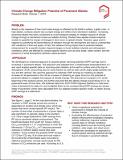| dc.description.abstract | Albedo is the measure of how much solar energy is reflected by the Earth’s surface. Lighter color, or high-albedo, surfaces absorb less sunlight energy and reflect more shortwave radiation. Increasing pavement albedo has been considered as a technological strategy to mitigate impacts of climate change through a mechanism known as radiative forcing. Studies have applied simple analytical models to quantify the impact of changes in land cover on global climate. However, gaps exist in regards to quantifying the transmittance of radiation through the atmosphere and due to uncertainties with variations in time and space. In fact, the radiative forcing impact due to pavement albedo enhancement for a specific location depends largely on local radiation intensity and atmospheric conditions, which are affected by context-specific factors such as solar angle, water content, and the presence of small atmospheric particles called aerosols. | en_US |
